

The Secret Languages of Ireland : Sampson, John. The Secret Language of Vagabonds and Traveling Hobos. Not surprisingly, vagabonds and traveling hobos have their own system of language which I’m sure dates back decades, if not centuries.

Some hobos now communicate via cellular phones and e-mail. But the classic American hobo of early this century communicated through a much more basic system of marks–a code through which they gave information and warnings to their fellow Knights of the Road. Usually, these signs would be written in chalk or coal on a trestle, fence, building or sidewalk, letting others know what they could expect in the area of the symbol. Check out the list of Hobo Signs & Symbols which seems a rather apropos addendum to the photo essay I mentioned a while back on The Underground World of Real Life Vagabonds.
My favorites: “Man with a gun lives here.” and “Kind woman lives here. In the Land of Invented Languages by Arika Okrent. Solresol language and stenographic script. Origin Solresol was invented by François Sudre (1787-1864).
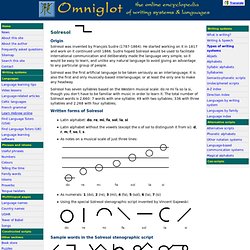
He started working on it in 1817 and work on it continued until 1866. Sudre hoped Solresol would be used to facilitate international communication and deliberately made the language very simple, so it would be easy to learn, and unlike any natural language to avoid giving an advantage to any particular group of people. Solresol was the first artificial language to be taken seriously as an interlanguage.
It is also the first and only musically-based interlanguage; or at least the only one to make any headway. Solresol has seven syllables based on the Western musical scale: do re mi fa so la si, though you don't have to be familiar with music in order to learn it. Written forms of Solresol. Lojban. Lojban class at Logfest 2011, San Mateo, California, USA.

Lojban is a carefully constructed spoken language designed in the hope of removing a large portion of the ambiguity from human communication. It was made well-known by a Scientific American article and references in science fiction Lojban has been built over five decades by dozens of workers and hundreds of supporters. Tenser, said the Tensor: "Darmok" Monday December 11, 2006 "Darmok" [This is part of an ongoing occasional series about linguistics in science fiction.
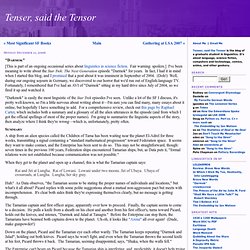
Fair warning: spoilers.] I've been meaning to write about the Star Trek: The Next Generation episode "Darmok" for years. Learn the Na'vi Language from the film Avatar.
Conlang Archives Mirror. Ranto (JBR AntiZamenhofism) Learn Not to Speak Esperanto has moved into this ToC-ified subdirectory to allow more room for appendices.
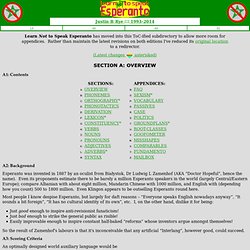
Rather than maintain the latest revisions on both editions I've reduced its original location to a redirector. (Latest changes asterisked) Babm. aUI, The Language of Space. What?!
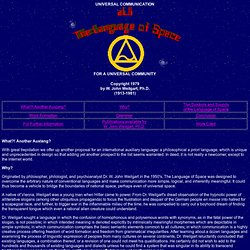
High Strangeness: The "Language of Space" How 18th-Century Copiale Cipher Was Cracked. Copiale. Kevin Knight, Beáta Megyesi, Christiane Schaefer The Copiale Cipher is a 105 pages manuscript containing all in all around 75 000 characters.
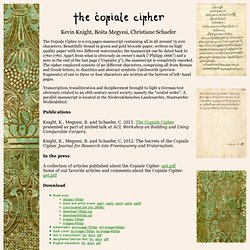
Beautifully bound in green and gold brocade paper, written on high quality paper with two different watermarks, the manuscript can be dated back to 1760-1780. Apart from what is obviously an owner's mark (“Philipp 1866”) and a note in the end of the last page (“Copiales 3”), the manuscript is completely encoded. The cipher employed consists of 90 different characters, comprising all from Roman and Greek letters, to diacritics and abstract symbols. Catchwords (preview fragments) of one to three or four characters are written at the bottom of left–hand pages. Transcription, transliteration and decipherment brought to light a German text obviously related to an 18th century secret society, namely the "oculist order".
Publications. The Codex Seraphinianus. DISCUSSED: Extremely Limited Editions, The Metamorphic Bicranial Rhino, French Booksellers, Grievous Errors, Italo Calvino, Pliny’s Natural History, Hieronymus Bosch, ’70s Pop Art, eBay, The Voynich Manuscript, Italian Aristocrats, Bodoni, In Watermelon Sugar, Ovid, Lewis Carroll’s Photographs of Children, Hypertext Fiction, Taxonomical Surveys, Alchemical Etchings, Billy Joel Image from Luigi Serafini’s Codex Seraphinianus.Click to enlarge.
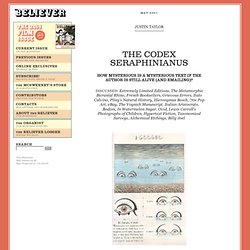
Who were the people who had invented Tlön? The plural is unavoidable, because we have unanimously rejected the idea of a single creator, some transcendental Leibnitz working in modest obscurity. —Jorge Luis Borges, “Tlön, Uqbar, Orbis Tertius” Like a Borges story, this is as much about the quest for knowledge as it is about the knowledge itself. At the beginning of my junior year of college, some friends and I came across an upper-division English class called Eccentric Spaces and Spatialities. Dr. One day Dr. Here is his Wikipedia entry, in full: Peter Schwenger Codex Seraphinianus. Peter Schwenger Codex Seraphinianus, Hallucinatory Encyclopedia This symposium, various no doubt in the approaches taken and examples offered, is gathered under the sign of Seeing Things.

But this unifying sign splits, and may be seen in two ways. First, if we say "he is seeing things" we are understood to be speaking of hallucination --the visual manifestation of unreal entities. Serafini's Codex: the Allien Encyclopedia. Codex Seraphinianus: Some Observations. They say that the text of the Codex Seraphinianus was never meant to mean anything; all the same, I mean to treat it here as if it was.
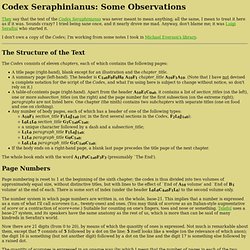
Sounds crazy? I tried being sane once, and it nearly drove me mad. Anyway, don't blame me; it was Luigi Serafini who started it. I don't own a copy of the Codex; I'm working from some notes I took in Michael Everson's library. The Structure of the Text. Op-Ed Guest Columnist - Twittergraphy. LINGUIST List 6.200: Humour: Optimal artificial languages. Mon 13 Feb 2005 FYI: Humour: Optimal artificial languages Editor for this issue: <> All of Beddy-Byes and a bit more - sci.lang. But first, my apologies. Having posted the first instalment I plumbforgotabout the rest. A congratulatory message from a passing Klingon visitorreminded me about Beddy-Byes and my failure to continue. There areEIGHT installments to it, would you believe, and I fear I may forgetor stuff up if I post them piecemeal. So here is the lot! Beddy-Byes or the Ultimate Centre-Embedding Language.
An even more primitive language, even more or perhaps less, - Google Groupes. The Analytical Language of John Wilkins. By Jorge Luis Borges Translated from the Spanish 'El idioma analítico de John Wilkins' by Lilia Graciela Vázquez; edited by Jan Frederik Solem with assistance from Bjørn Are Davidsen and Rolf Andersen. A translation by Ruth L. C. Simms can be found in Jorge Luis Borges, 'Other inquisitions 1937-1952' (University of Texas Press, 1993) I have noticed that the 14th edition of Encyclopedia Britannica does not include the article on John Wilkins. An Essay towards a Real Character and a Philosophical Language. An Essay towards a Real Character, and a Philosophical Language (London, 1668) is the best-remembered of the numerous works of John Wilkins, in which he expounds a new universal language, meant primarily to facilitate international communication among scholars, but envisioned for use by diplomats, travelers, and merchants as well.
Unlike many universal language schemes of the period, it was meant merely as an auxiliary to — not a replacement of — existing "natural" languages. The first edition cover page Background[edit] There was immediate interest in the Essay; Wilkins is said to have regarded his work only in terms of a proof of concept.[6] But in the medium term enthusiasm for this kind of constructed language declined. The problem of a universal language remained as a topic of debate.[4] Enochian” language: A proof of the existence of angels? Enochian. The language found in Dee and Kelley's journals encompasses a limited textual corpus, only some of it with English translations. Several linguists, notably Donald Laycock, have studied Enochian, and argue against any extraordinary features in the language.
Enochian Linguistics.